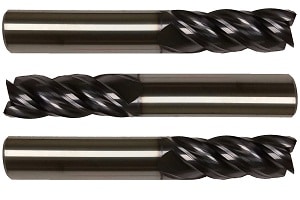It seems that, no matter how much literature about machining here is out there, there is always an interest in discovering better ways of reducing chatter when machining parts, especially when they’re made of hard materials or when going at them at increased feed rates.

One simple way is to upgrade your tooling materials and adopt rigid and solid carbide. The combination of 80%-95% tungsten carbide sintered with cobalt for added toughness makes it the perfect material for increased accuracy. Steel tools are extremely sharp, but their flexibility makes them tend to wobble when attacking materials at high speeds, making them prone to chatter and producing uneven finishes. Carbide tools reduce this vibration, considerably reducing chatter, at least up to certain speeds.
But what if we want to increase feed rates and speed?
We are, of course, talking about high-performance machining. Even the hardness of carbide tools is not enough to hold the effects of vibrations at high speeds. However, understanding the nature of chatter can get us closer to obtaining the desired stability we need for less interruption and even surfaces.
Contrary to what many shop owners state online, chatter is not produced by going too hard or violently on the material when we initiate our tool path. Even if you effectively find purchase and follow a stable path at even feed rates, chatter will appear when a certain resonance occurs.
When our tool performs a pass, it leaves certain waves on the surface of the material, analog to those found on vinyl records. These waves are perfectly in tune with the vibration of your tool, when they reach a harmonic synchronization, they start vibrating and produce that familiar chatter noise. Finding a speed that is below the harmonic resonance is one way of dealing with this problem. However, that usually means running at subpar productivity levels, which is not ideal for shops trying to fulfill higher production quotas.
The next best thing is to get high-quality carbide variable flute end mills.
Regular flutes strike the material at regular intervals, increasing the chances of resonance and oscillation, giving way to chatter. The unique geometry of variable helix designs creates irregular spacing between cutting edges, making the tool strike the material unevenly, making it close to impossible to enter that dreaded resonance valley that causes chatter. Variable flute mills allow you to increase feed rates and go harder on the material for enhanced efficiency.
Weird end mill design is a product of intense research and computer modeling to find the right shapes that effectively reduce harmonics when striking workpieces at different frequencies. Variable helix and pitch angle changes along the flutes are the result of an ever-evolving art. Coming up with angles and curves that not only reduce vibration but also increase tool life and cutting volume is a product of huge advancements in tool engineering.
Most of these tools feature titanium aluminum nitride to provide the tool with enhanced friction properties for better chip evacuation and temperature refraction. This increases the tool’s durability even at higher speeds or dry milling.
Machinists are no longer constrained by the limitations of traditional materials or geometries. The rigidness of a carbide core, the insulation properties of titanium aluminum nitride coatings, and the exotic geometry of variable flute end mills will give any shop the power it needs to take machining to the next level.
If you want the best carbide variable flute end mills, you must contact Online Carbide. They provide the best carbide tools for high-performance machining at the best prices. Visit their website today or call them between 8 am to 5 pm CST at 630-238-1424 for more personalized attention.
For more information about Carbide Thread Mill Npt and Carbide Cutting Tools Please visit: Online Carbide.




